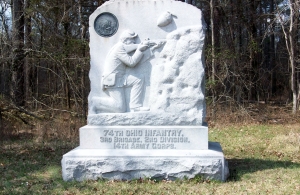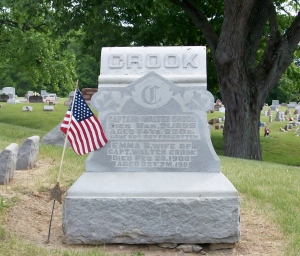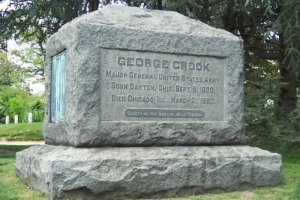Brothers in Arms, 150 Years Ago Today
 Monument of the 74th OVI, Chickamauga National Battlefield.
Monument of the 74th OVI, Chickamauga National Battlefield.Over the next couple of days, I will be posting a series of short articles on the men and units of the Buckeye State who fought in the Battle of Chickamauga. Below is the first article in this series.
While the exploits of Brigadier General George Crook during the American Civil War and the Indian Wars that followed are well documented, what is little-known is that George’s older brother, Walter, raised and served as the Captain of Company F, 74th Ohio Volunteer Infantry. Company F’s roster included many men from the Vandalia and Butler Township, Ohio, area where I currently reside.
Captain Crook, who was severely wounded in the thigh at Stones River, commanded Co. F throughout the entire war. In my view, Captain Crook (as he liked to be called) was a perfect example of the company grade officers of the war, who, after leading their neighbor “citizen soldiers” through many difficult marches and battles, returned home and help rebuild a country torn apart by four years of civil war.
The battlefield of Chickamauga was the only one shared by the brothers during the conflict. George was in command of the Second Division of the Army of the Cumberland’s Cavalry Corps, while Walter was leading his beloved Company F of the 74th Ohio which was serving in the 3rd Brigade, 2nd Division, XIV Corps, also with the Army of the Cumberland. Even though their units were separated by less than a mile during the night of September 19th, it is highly doubtful they had the opportunity to meet, even for a few hurried words over a cup of coffee and a piece of hardtack.
Both brothers survived the battle and the war, with George gaining even more fame after the war as arguably the best Indian fighter in the army. Though five years younger than Walter, he died eight years earlier in 1890 of a sudden heart attack. Today he rests at Arlington Cemetery under an imposing granite monument inscribed with not only his military commands and accomplishments, but also an engraving of his meeting with the great Apache war chief Geronimo, who greatly respected the man the Apache had dubbed “Nantan Lupan,” or “Grey Wolf.”
As for Walter, after mustering out in 1865, he returned home to Butler Township, Ohio, and became a rather prominent businessman in his community. He worked as both the freight agent and postmaster of the small crossroads hamlet of Tadmor, and served a term in the Ohio Senate. Never forgetting his men of Co. F, Walter was a founding member of the Milton Weaver GAR Post 594 in Vandalia (named after a young soldier of Company F who fell at the battle of Jonesboro, Georgia). Walter passed away in1898, and he lies buried in Maple Hill Cemetery in Tipp City, Ohio, near many of his fellow “Boys of 61” who followed him to war all those many years before. His headstone inscription is a simple one, with the usual information of age and date of death, along with a simple motto of “Gone, But Not Forgotten.” But, before his name, the headstone is inscribed with the one word that perfectly defined this man, and speaks volumes of the importance of that period of his life when Walter led the men and boys of Company F, on the march, in camp, and through the horrific crucible of battle.
That word is Captain.
 Gravestone of Captain Walter Crook, Co. F 74th OVI. Maple Hill Cemetery. Tipp City, Ohio
Gravestone of Captain Walter Crook, Co. F 74th OVI. Maple Hill Cemetery. Tipp City, Ohio Gravestone of Major General George Crook, Arlington National Cemetery.
Gravestone of Major General George Crook, Arlington National Cemetery.